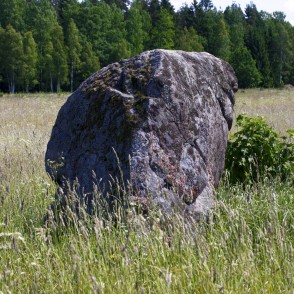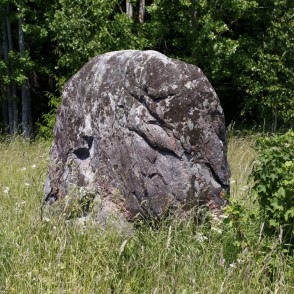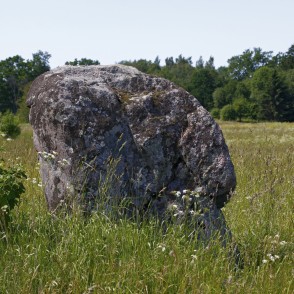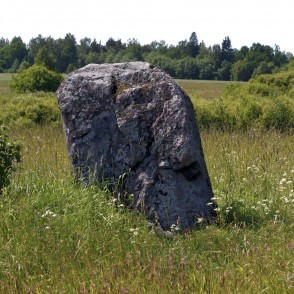Location
State: Latvia
Region: Kurzeme
County: Dundaga
Parish: Dundaga
Other references to the location
In an open area, in a meadow, not far from Āži, short 100 m of the Āži–Neveja road.
Description
The Steep Stone (Stāvakmens), as it was called at the end of the 20th century, has been located in this place for many thousand years. The ascent of the stone is attracting attention because its height is a little larger than the width and length. The stone is 2 m high and 4.8 m in circumference. Although many believe the stone has been erected vertically, geology specialists know that it could be so situated also in a natural way — when glacier was melting. The stone itself is not grand in its size, but it is of archaeological significance. It is a cup-marked stone, on the top side, top surface of which there had been 4 cup marks carved before 2000–3000 years. There are no other carvings on the stone. According to its composition, it is of red granite, overgrown with lichen and minor moss. It is distinguished for being the furthest to the north of North Kurzeme known cup-marked stone.
Narrative
As a cup-marked stone it was discovered in 2003 (J. Cepītis), but before this the stone was known as a probable border stone, which has not been certainly proven. The stone is uncommonly vertical, thus it has been called the steep stone. In sources ("Kurzeme" (R., 1993)) it was mentioned that around the stone there used to be many other "holy stones" that had been pushed together from the field into the nearby bosket. Up till now, however, there have been no cultural-historical stones found in the bosket. Of course, the surroundings have been affected by the land amelioration of the Soviet Times. What it looked like before, one can only guess now, but in any case the Āži Steep Stone is interesting as an ancient cult stone with cup mark carvings. Historians have offered more than 30 different versions about the reasons of carvings, out of which the more credible ones are related to cult rituals held at such stones. The name of Āži (billy goats) has been given to the stone due to the name of the nearby homestead, and, supposedly, there is no direct relationship to the animals themselves.
www.ancientsites.eu






